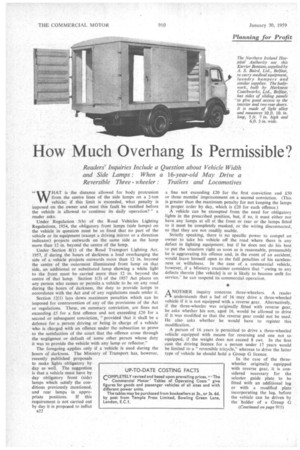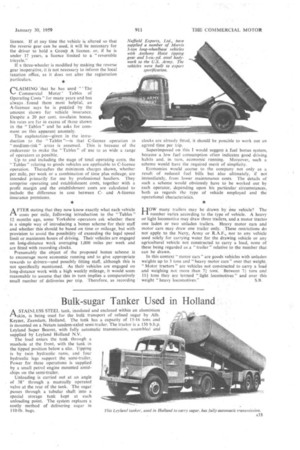How Much Overhang Is Permissible?
Page 160

Page 163

If you've noticed an error in this article please click here to report it so we can fix it.
Readers' Inquiries Include a Question about Vehicle Width and Side Lamps : When a 16-year-old May Drive a Reversible Three wheeler .• Trailers and Locomotives
" HAT is the distance allowed for body protrusion from the centre lines of the side lamps on a 2-ton vehicle; if this limit is exceeded, what penalty is imposed on the owner and must this fault be rectified before the vehicle is allowed to continue its daily operation?" a reader asks.
Under Regulation 5(b) of the Road Vehicles Lighting Regulations, 1954, the obligatory front lamps (side lamps) on the vehicle in question must be so fixed that no part of the vehicle or its equipment (except a driving mirror or a direction indicator) projects outwards on the same side as the lamp more than 12 in. beyond the centre of the lamp.
Under Section 8(1) of the Road Transport Lighting Act, 1957, if during the hours of darkness a load overhanging the side of a vehicle projects outwards more than 12 in. beyond the centre of the outermost illuminated front lamp on that side, an additional or substituted lamp showing a white light to the front must be carried more than 12 in. beyond the centre of that lamp. Section 1(3) of the 1957 Act places on any person who causes or permits a vehicle to he on any road during the hours of darkness, the duty to provide lamps in accordance with the Act and of any regulations made under it.
Section 12(1) lays down maximum penalties which can be imposed for contravention of any of the provisions of the Act or regulations. These, on. summary conviction, are fines not exceeding £5 for a first offence and not exceeding £20 for a second or subsequent conviction, "provided that it shall be a defence for a person driving or being in charge of a vehicle who is charged with an offence under the subsection to prove to the satisfaction of the court that the offence arose through the negligence or default of Some other person whose duty it was to provide the vehicle with any lamp or reflector."
The foregoing applies only if a vehicle is used during the hours of darkness. The Ministry of Transport has, however, recently published proposals to make lights obligatory by day as well. The suggestion is that a vehicle must have by day obligatory front (side) lamps which satisfy the conditions previously mentioned, and rear lamps in appropriate positions. If this requirement is not carried out by day it is proposed to inflict a22 a fine not exceeding £20 for the first conviction and £50 or three months' imprisonment on a second conviction. (This is greater than the maximum penalty for not keeping the lamps in proper order by day, which is £20 for each offence.) A vehicle can be exempted from the need for obligatory lights in the prescribed position, but, if so, it must either not have any lamps at all at the front or rear or the lamps fitted to it must be completely masked, or the wiring disconnected, so that they are not readily usable.
Strictly speaking, there is no specific power to compel an owner to take his vehicle off the road where there is any defect in lighting equipment; but if he does not do his best to put the situation right as soon as is reasonable, presumably he is aggravating his offence and, in the event of an accident, would leave himself open to the full penalties of his carelessness or wilfulness. In the case of a commercial vehicle, however, if a Ministry examiner considers that "owing to any defects therein [the vehicle] is or is likely to become unfit for service," he can suspend its commercial operation.
ANOTHER inquiry concerns three-wheelers. A reader
understands that a lad of 16 may drive a three-wheeled vehicle if it is not equipped with a reverse gear. Alternatively, if the three-wheeler was originally fitted with reverse gear, he asks whether his son, aged 16, would be allowed to drive if it was modified so that the reverse gear could not be used. He also asks whether he would have to register this modification.
A person of 16 years is permitted to drive a three-wheeled vehicle equipped with means for reversing and one not so equipped, if the weight does not exceed 8 cwt. In the first case the driving licence for a person under 17 years would be limited to a "reversible tricycle,” whereas to drive the latter type of vehicle he should hold a Group G licence.
In the case of the threewheeler originally equipped with reverse gear, it is considered necessary for the selector guide plate to be fitted with an additional lug or with a modified plate incorporating the lug, before the vehicle can be driven by the holder of a Group G (Continued on page 911)
licence. If at any time the vehicle is altered so that the reverse gear can be used, it will be necessary for the driver to bold a Group A licence, or, if he is under 17 years, a licence limited to a "reversible tricycle."
If a three-wheeler is modified by making the reverse gear inoperative, it is not necessary to inform the local taxation office, as it does not alter the registration particulars.
rLAMING'that he has used "'The
Commercial Motor' Tables of Operating Costs" for many years and has always.found them most helpful, an A-licensee says he is puzzled by the amount shown for vehicle insurance. Despite a 20 per cent, no-claim bonus, his rates are far in excess of those shown in the " Tables " and he asks for comment on this apparent anomaly.
The explanation—given in the intro.
&talon to the Tables "—is that C-licence operation in " medium-risk " areas is assumed. This is because of the endeavour to make the "Tables" of use to as wide a range of operators as possible.
Up to and including the stage of total operating costs, the " Tables " relating to gOods vehicles are applicable to C-licence operation. Thereafter the minimum charges shown, whether per mile, per week or a combination of time plus mileage, are intended primarily for use by professional hauliers. They comprise operating and establishment costs, together with a profit margin and the establishment costs are calculated to include the difference in cost between Cand A-licence insurance premiums.
A FTER stating that they now know exactly what each vehicle
costs per mile, following introduction to the " Tables " 12 months ago, some Yorkshire operators ask whether there is a simple way of introducing a bonus scheme .for their staff and whether this should be based on time or mileage, but with provision to avoid the possibility of exceeding the legal speed limit or maximum hours of driving. Their vehicles are engaged on Tong-distance work averaging 1,000 miles per week and are fitted with recording clocks.
• Presumably the object of the proposed bonusscheme is to encourage more economic running and to give appropriate rewards to drivers—and possibly fitting staff, although this is not specifically mentioned. As their vehicles are engaged on long-distance work with a high weekly mileage, it would seem reasonable to assume that this in turn implies a comparatively small number of deliveries per trip. Therefore, as recording
clocks are already fitted, it shoultt be possible to work out an agreed time per trip.
Superimposed on this I would suggest a fuel bonus system, because a low fuel consumption often indicates gooddriving habits and, in turn, economic running, Moreover, such a scheme would have the required merit of simplicity.
Economies would accrue to the company not only as a result of reduced fuel bills but also ultimately, if not immediately, from lower maintenance costs. The details of such a scheme would obviously have to be worked out by each operator, depending upon his particular circumstances, both as regards the type of vehicle employed and the operational characteristics.
HOW many trailers may be drawn by one vehicle? The number varies according to the type of vehicle. A heavy or light locomotive may draw three trailers, and -a motor tractor one laden or two unladen trailers. Heavy motor ears and motor cars may draw one trailer only. These restrictions do not apply to the Navy, Army or R.A.F., nor to any vehicle used solely for carrying water for the drawing vehicle or any agricultural vehicle not constructed to carry a load, none of these being regarded as a " trailer " relative to the number that can be drawn.
In this context "motor cars" are goods vehicles with unladen weights up to 3 tons and "heavy motor cars" over that weight. "Motor tractors" are vehicles not constructed to carry a load and weighing not more than 71 tons'. Between 71 tons and 111 tons they are termed "light locomotives" and over this weight "heavy locomotives." S.B.




































































































































































































